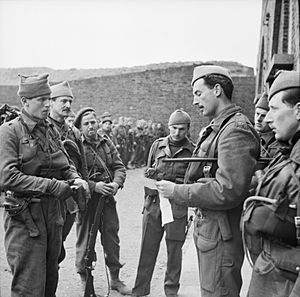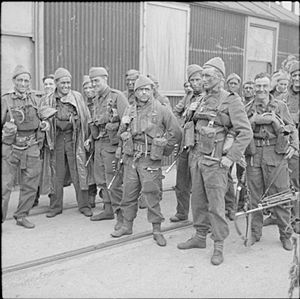Operation Abercrombie facts for kids
Quick facts for kids Operation Abercrombie |
|||||||
|---|---|---|---|---|---|---|---|
| Part of North West Europe Campaign | |||||||
|
|||||||
| Belligerents | |||||||
| Commanders and leaders | |||||||
| Lord Lovat | |||||||
| Strength | |||||||
| 100 British commandos 50 Canadian Infantry Royal Engineers |
Unknown | ||||||
| Casualties and losses | |||||||
| 1 injured | Unknown | ||||||
During World War II, Operation Abercrombie was a secret mission. It involved soldiers from the United Kingdom and Canada. Their goal was to check out the French coast near a village called Hardelot. This village is located south of Boulogne-sur-Mer in France.
The mission was first planned for April 19-20, 1942. But it was delayed until April 21-22. The soldiers didn't face much resistance from the enemy. However, after the mission, leaders decided it wasn't very successful. A group of Canadian soldiers even got lost and had to turn back.
Contents
What Was the Mission?
Operation Abercrombie was a "reconnaissance in force." This means the soldiers went to explore an area and gather information. They also planned to fight if needed.
Main Goals of the Mission
- To explore the beaches near Hardelot village.
- To capture enemy soldiers for questioning.
- To destroy enemy equipment, especially a searchlight battery.
Getting Ready for the Mission
The team for this mission included about 100 British commandos from No. 4 Commando. There were also 50 Canadian soldiers from the Carleton and York Regiment. Some Royal Engineers (soldiers who build and destroy things) joined them too. Major Lord Lovat was in charge of the whole operation.
Training and Travel
The commandos trained in England, in places like the New Forest. They practiced on a ship called HMS Prince Albert. This ship took them to Dover, a port city in England. From Dover, they would travel to France on fast boats called motor gun boats (MGBs). These MGBs would tow smaller boats called assault landing craft (LCAs). The LCAs were designed to get soldiers onto the beach.
How the Landing Would Work
One group of commandos, called C Troop, was supposed to land first. Their job was to clear any obstacles and secure the beach. Then, another group, B Troop, would move past them. B Troop would go further inland to complete their tasks. After the mission, everyone would return using the LCAs.
The Raid Begins
This mission was the first time a new type of landing craft, the LCA (Landing Craft Assault), was used. These new boats had two machine guns and a mortar (a type of small cannon).
First Attempt Fails
The boats set off on the evening of April 19. But after two hours, one of the LCAs started taking on water and sank. The two crew members were saved, but two commandos were lost. After searching for a while, the mission was called off, and the boats returned to Dover.
Second Attempt and Challenges
A second attempt was made on April 21, with a new LCA. This time, the Canadian soldiers had trouble navigating. They got separated from the main group. They even drew tracer fire (bullets that glow) from the shore. Their own MGBs fired back. Because of these problems, no Canadian soldiers landed in France.
The British commandos landed further north than they planned. But they didn't face any immediate resistance. They weren't spotted until they were already among the sand dunes and wire fences. German tracer fire came from the sides, but the LCAs fired back, helping the commandos move forward.
On the Ground
As the commandos advanced, they found that the German defenses were weak or abandoned. They only met three German soldiers up close, who quickly retreated. The official report said there was "no determined opposition." A small group of 12 men was sent to destroy the searchlights. They reached their target but had to turn back. A signal rocket told them time was running out.
The only Allied soldier injured was a commando. He was shot in the ankles by a friendly sentry on the beach. This happened because he didn't respond quickly enough to a challenge. Meanwhile, Navy boats supporting the mission fought with enemy ships, including E Boats. They sank at least one enemy boat and damaged others. Three Navy sailors were injured. The number of German casualties was unknown.
What Was Learned?
The experiences from Operation Abercrombie were very important. They helped plan a much larger mission called Operation Jubilee. This big raid happened in Dieppe, France, a few months later in August.



